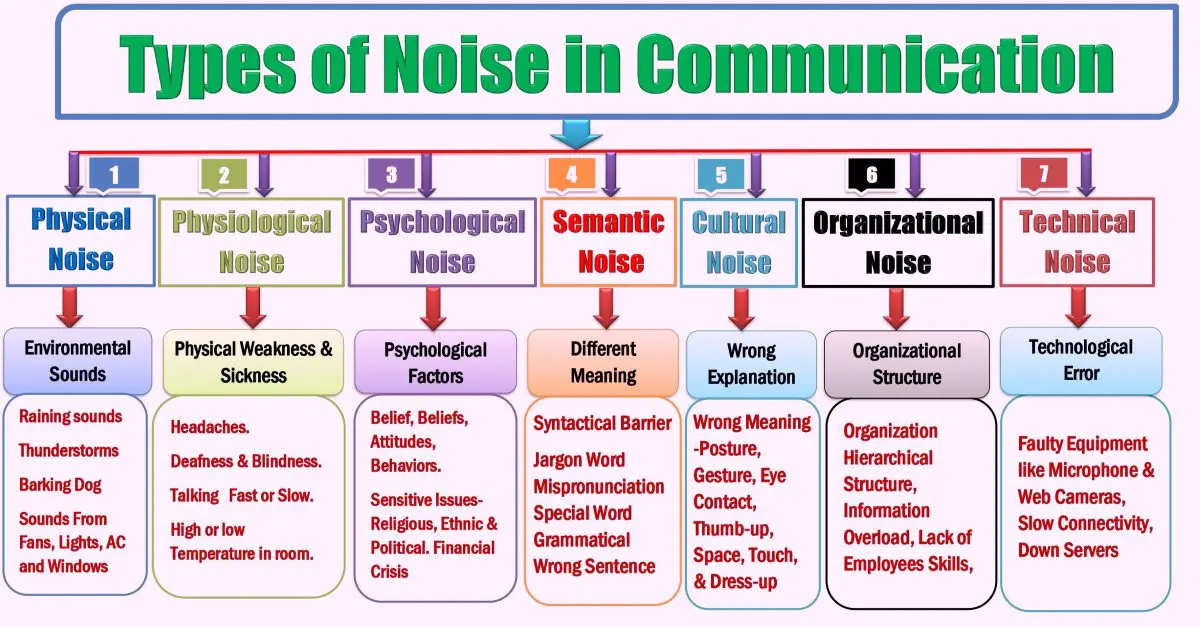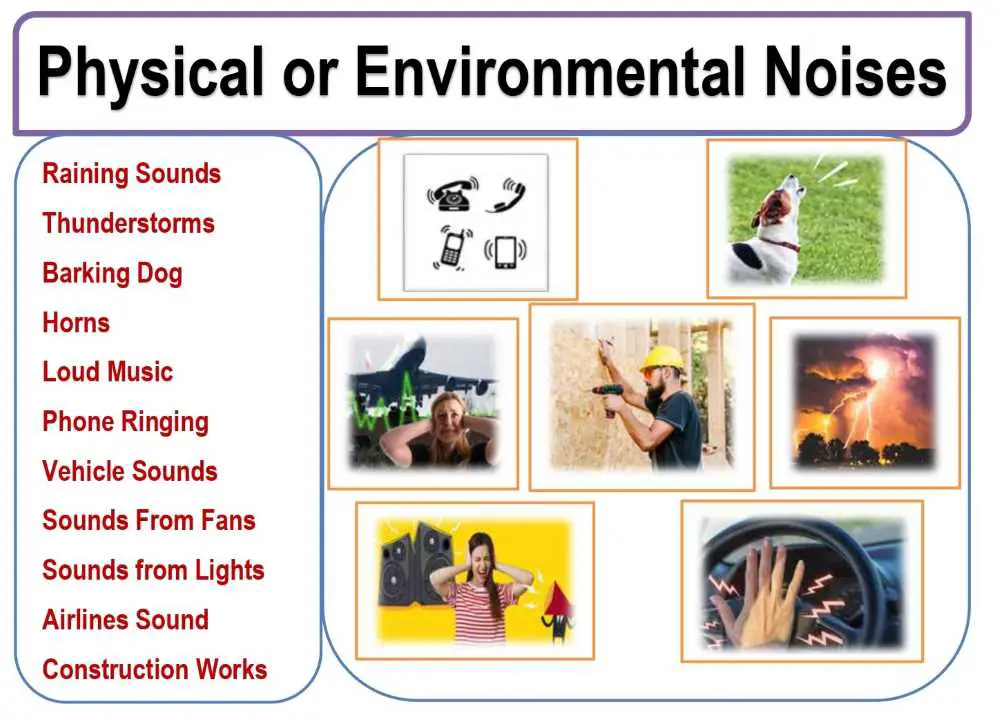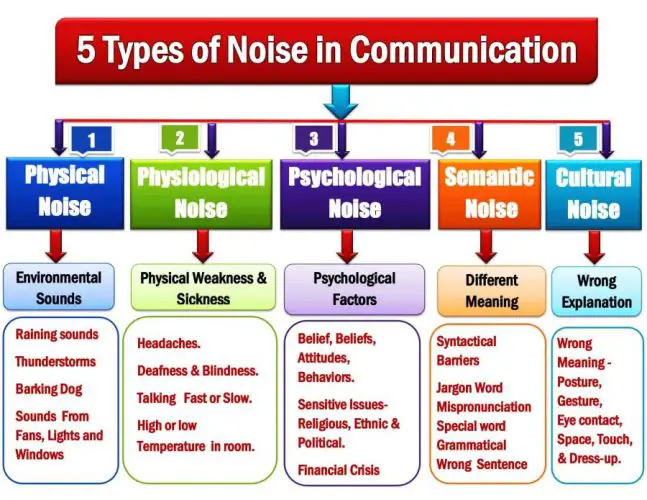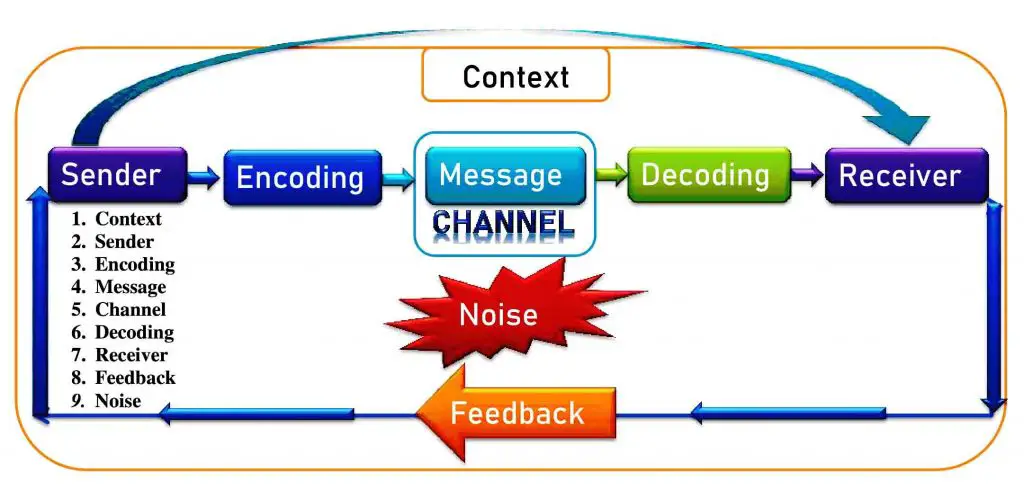The Seven Types of Noise in Communication are Physical, Physiological, Psychological, Semantic, Cultural, Organizational and Technical Noise.
Communication Noise
Communication noise means any barrier to the effective communication process. Noises bar the effective communication process between senders and receivers. The different types of noise in communication are physical or environmental, factual, physiological, psychological, semantic, cultural, organizational, and technical noise.
These noises distract the sender and receiver of the communication process from listening to the message effectively. Noise bars the effectiveness of the communication process; therefore, it is also known as a barrier to effective communication. It is one of the unwanted communication elements, followed by Context, Sender, Encoder, Message, Channel, Decoder, Receiver, and Feedback.
Communication noises are presented in all communication contexts, such as face-to-face, group, organizational, and technical communication. The researchers have mentioned the noises as an element of every type of theory including linear, interactive, and transactional communication models.
Shannon and Weaver’s communication model introduced noise initially in the linear communication model in 1949. Later, many researchers include the noise in their theories. A comprehensive communication model includes noise and feedback to explain the communication process.
The communication process gets more effective, productive, and interactive if there is no noise. Many scholars are researching to find out the solution to overcome noise in communication. Researchers have identified that in the U.S.A., business organizations are losing billions of dollars due to noise in communication.
Different Types of Noise in Communication

Real-Life Example of Noises in Communication
Hearing a loud horn during a phone call is a real-life example of noise in communication. Vehicle horns always bar the receiver from receiving and processing information. For example, Elly is very sick; hence, calls her husband (Jack ) to bring some medicines over a phone call. At the same time, a driver honks the horn to get a dog out of the way. Therefore, Jack could not understand clearly what his wife said to bring. So, he asks his wife again to be confirmed.
The horn sounds are physical noise, and her sickness is an example of physiological noise. Both noises interfere with the communication process.
Types of Noise in Communication
The author studies several articles published in reputed journals including Sage and the International Journal of Communication. These articles demonstrate different types of noises for example, Brogan explains semantic noise in communication in 1974. In this article, the author gathers all types of noises mentioned in academic journals and represents them with real-life examples.
Seven Types of Noises in Communication are:
- Physical Noise
- Physiological Noise
- Psychological Noise
- Syntactical Noise
- Cultural Noise
- Organizational Noise
- Technical Noise
The seven types of noise in communication are physical or environmental, factual, physiological, psychological, semantic, cultural, organizational, and technical noise. However, some additional noises in the communication process include group communication noise, syntactic, emotional, medium, encoding, decoding noises, etc.
1. Physical Noise in Communication
Physical noise is the external and unnecessary sound that is an obstacle to effective communication. It is also a communication disturbance created by the environment. Therefore, physical noise is also known as environmental or factual noise in communication. Factual noise comes from ambient background noise in the environment.
Example of Physical Noise
For example, rain, thunderstorms, phone ringing, horns, airlines sound, whispering, outside building sounds, and sounds from fans, lights, and windows are the best examples of physical or environmental noise. Besides loud music, barking dogs, and noisy conflict nearby, vehicle sounds are examples of physical noise. These are also examples of factual noise in communication.

Factual Noise Example
“Image the top management professionals organizing a meeting to amend company rules and regulations, the HR manager tried to propose a list of new rules related to working time. However, the meeting room was filled with factual noise as employees whispered and raised issues related to pension and lunch break rules. Despite the HR managers trying to steer to the working time issue, the factual noise interfered and persisted decision-making process”.
2. Physiological Noise in Communication
Physiological noise is a barrier created by the communicator’s physical and physiological condition. Mental and Physical illness and weakness produce physical noises, which is an obstacle to effective communication.
Example of Physiological Noise
For example, Ela is having headaches; therefore, she can not concentrate in class. Here, a headache is a physical illness that hinders the listening process of communication. Also, deafness and blindness are physical weaknesses or physiological noises that hinder listening. Talking too fast or slow and the high or low temperature in the room also generate physiological noise.
3. Psychological Noise in Communication
Psychological noise is a communication barrier created by the communicator’s psychological factors, for example, values, beliefs, attitudes, and behaviors. This type of noise interrupts our minds from concentrating on listening. People don’t like to listen or talk about those topics that make them down or not enjoyable. Apart from that, ethnocentrism, prejudices, stereotypes, and discrimination are also examples of psychological noises. These factors bar effective communication in a group or team. The four noises in group communication are ethnocentrism, prejudices, stereotypes, and discrimination. Psychological noises in communication interfere with respect and accept other opinions.
Example of Psychological Noise
For example, Elly is a Muslim girl who does not like to listen to any criticism of Islam. Therefore, she became distracted when her lecturer was talking about anti-Islam issues. Any sensitive issues like religious, ethnic, and political are examples of psychological noise. Apart from that, financial crisis, missing a beloved person, and an exhausting schedule may cause psychological noise.
4. Semantic Noise in Communication
Semantic noise is a communication barrier created by confusion over the meaning of words. It comes from complex, technical, autochthonous, or grammatical errors in communication. Semantic noise occurs because of different message definitions between the sender and receiver. It also refers to the wrong grammatical sentence that makes the receiver unable to understand the meaning. Scholars term it as a syntactical barrier or noise.
Syntactical noise is a grammatically wrong sentence in which the receiver cannot accomplish the proper meaning. Using complex language during computer programming is an example of syntactical noise. It is also in contrast to syntactic sugar.
Example of Semantic Noise
Ela is an international student who studies at the University of Putra Malaysia. She is listening to lectures from her Malaysian lecturer. In the meantime, her lecturer says, ” I believe SEMUA understand this topic.” SEMUA is a Malaysian word that means everyone. Ela does not understand the meaning of SEMUA as she is not a Malaysian student. It is an example of semantic noise.
Similarly, a lecturer says the natural causes of climate change and global warming are different facts. However, a few students are confused about the lecturer’s statement. The confusion has come from semantic noise. These students believe that climate change and global warming are the same phenomena. Finally, the lecturer describes global warming as raising the environment’s temperature. On the other hand, climate change points to both increasing and decreasing the global temperature. It is also an example of semantic noise.
Additionally, jargon words, mispronunciations, unique words, and grammatically wrong sentences are Semantic Noise examples.
Examples of Semantic Noise
1. Jargon or Technical Language: Semantic noises can be portrayed when a speaker uses a technical term, specialized language, idiom, or abbreviation. Receivers might not understand if they are not familiar. For example, a lecturer orders their student to write an SOP example as a final assignment and submit it before the final exam. SOP might short form of standard operating procedures or a statement of purpose. It makes students confused.
2. Ambiguity: Ambiguous language conveys confused messages that generate misunderstanding. For example, if an applicant says “I will email a resume with cover letter soon”. In this scenario, Soon might not specify the timeframe exactly when the applicant will email the resume.
3. Slang or Colloquialisms: The use of slang or colloquial language might convey confused information. These terms bar the communication process depending on the receivers’ age and context. For example, the word “cool” might convey confused messages to the older generation.
4. Misinterpretation of Nonverbal Cues: Nonverbal communication cues including body language, gestures, and artifacts may lead to misinterpretation of the message. For example, a smile might signal friendliness and ignorance depending on context.
5. Cultural Noise in Communication
Cultural noise is a communication barrier created by cultural dissimilarities explaining another person’s behaviors differently. This noise can be produced due to the wrong meaning of messages; therefore, it is known as semantic noise. Especially cultural noise is created from the nonverbal communication of people from different cultural backgrounds. The basic kinds of nonverbal communication cues are posture, gesture, eye contact, space, touch, and dress-up. The meaning of nonverbal cues is not the same in every culture and society. The conflicting message in communication is one of the cultural noises.
Cultural noises can be depicted in various forms, including language barriers, nonverbal communication, cultural stereotypes, cultural norms and values, and cultural differences.

Cultural Differences: The same language and words depict different meanings in different cultures. For example, the phrase “Thumbs up” indicates a positive indication in the USA and European countries. Contrastingly, the phrase “Thumbs up” indicates negative meaning in Middle Eastern countries including Iran and Afghanistan.
Example of Cultural Noise
Jon is a Russian citizen who is studying at the University of Putra Malaysia. He offers his Malaysian woman friend to handshake, but she denies it. It makes Jon feel very embarrassed. Later, he understood that women do not like to handshake with men in Malaysia, which is a cultural norm.
6. Organizational Noise in Communication
Organizational noise occurs when the communication flow gets impeded because of organizational structure, information overload, and demographical and cultural differences among employees. It also happens depending on the lack of sensitivity, knowledge, and communication skills among new and existing employees. The new employees hold low communication skills, insufficient knowledge of the subject, emotional interference, etc. According to Geert Hofstede’s cultural dimensions, monochronic members in an organization prefer to complete tasks on time; in contrast, polychronic members are continually late to complete office tasks.
Example of Organizational Noise
For example, new employees do not know to whom they should submit the monthly report. In this scenario, noise occurs for complex organization hierarchical structure. A flat and decentralized organizational structure provides great freedom for employees to make decisions. Netflix’s flat organizational structure reduces communication noises.
7. Technical Noise in Communication
Technical noise occurs when the sender and receiver converse through defective communication channels and tools. The barriers come from faulty technological equipment like a mobile, laptop, slow internet connection, microphone, and web camera. It is related to information and communication technology and electrical devices including email delivery problems, television signal interference, and webpage loading errors.
Therefore, it is known as electrical noises in technology-based communication. Electrical Noise differs in shot and thermal barriers. Shot noise originates from the audio output of receivers. Thermal noise is generated from the random movement of electrons in the electronic device.
Example of Technical Noise
For example, a lecturer conducts online classes through Google Meet. A student can not hear the lesson because of a slow internet connection. Another student is unable to hear the class due to a headphone problem.
Apart from these five basic types of noises, the additional noises in the communication process are technical noise including shot and thermal noise, organizational noise, and noise in group conversation.
Advantages and Disadvantages of Communication Noise
Advantages of Communication Noise
Despite its negative aspects, communication noise can sometimes offer advantages in certain contexts including enhancing creativity, enriching communication studies, increasing awareness, and facilitating innovation. The following strengths of communication noise are adopted from ChatGPT.
Enhanced Creativity: Communication noise influences people to be creative to resolve problems. Human beings find alternative ways when they encounter barriers. Hence, communication noise makes people creative, innovative, and critical thinkers.
Enrichment of Communication Studies: Researchers conduct more research on noise in communication; therefore, it enhances the learning opportunity. Many scholars studied to reduce communication barriers. These researches enrich the literature of communication context.
Increasing Awareness: Scientists invented noise-related problems, including anger, sickness, and stress. Many researchers articulated that environmental noise such as loud sounds above 70 dB can damage the eardrum. It highlights social awareness.
Facilitation of Innovation: Finally, communication noise triggers individuals to innovate solutions to overcome noise as barriers to effective communication process. It fosters a culture of innovation in society and organizations.
Disadvantages of Communication Noise
The five disadvantages of communication noise are the effect on physical and mental health, miscommunication, reduced message clarity, damage organization’s reputation, and communal violence.
Noise Effects on Physical and Mental Health
Firstly, noises make people exhausted, anxious, irritated, dissatisfied, tense, angry, and sick. Babies and ill people cannot sleep due to environmental noise. People can become deaf if they stay with a loud noise for a long time. Noise above 70 dB damages the eardrum. In 2022, researchers at HARVARD Medical School identified that people encounter autonomic stress reactions when they wake up from a loud sound (Environmental Noise); and it might cause cardiac arrest.
Miscommunication
Noise bars effective communication and generates misunderstanding. Sometimes, psychological and semantic noise spreads misleading information. Organizational noise leads to damage to the company’s reputation.
Reduced Message Clarity
Noise reduces the clarity of the message by introducing distortion. It affects the receiver to interpret meaning accurately. In some scenarios, noise in communication can lead to losing important messages.
Damage Organization Reputation
Noise hampers organizations financially by reducing employees’ productivity. The workers cannot concentrate appropriately due to noise. The organizational noise occurs due to a faulty communication channel. Communication noise can tarnish an individual’s or organization’s reputation.
Create Communal Violence
Semantic noise spreads misleading information among people. Sometimes, it creates communal violence if the message comes from political or social leaders. Political group members are indulged in spreading fake information and creating communal riots.
Noise in Group Communication
Barriers to Group Communication are disturbances that hinder interactive communication among group members. The barrier in group communication usually hinders understanding other members of the group or team. The four types of barriers in group communication are Ethnocentrism, Stereotyping, Prejudice, and Discrimination. The group discussion has many stages, tensions, conflicts, etc. According to Tuckman’s Theory, the five stages of group discussion are Forming, Storming, Norming, Performing, and Adjourning. Members must overcome all these stages to achieve the independent and interdependent goal.
Difference Between Noise and Barrier
Noise and Barriers in conversation denote the same meaning, although people use them in different interaction contexts. For example, people use the word noise when encountering face-to-face or group communication obstacles. On the other hand, people use the word barrier when facing corporate communication or mediated communication obstacles. Noise refers to the hindrance during the interaction between sender and receiver. However, many people, including scholars, described them as noise barriers. People also term them a distraction, distortion, disturbance, etc.
Conclusion
In conclusion, the 7 types of communication noises are Physical, Physiological, Psychological, Semantic, Cultural, Organizational, and Technical Noise. Noises adversely impact personal, social, political, and organizational contexts. Hence, communicators should reduce noise as much as possible to make communication more effective, productive, and efficient. These communication noises are prevalent in every context of the communication process, such as barriers in face-to-face communication, mediated communication, corporate communication, and group communication. Noise is an unwanted element of the communication process.
The Five Types of Noise in Communication Image:

Citation for this Article (APA 7th Edition)
| Kobiruzzaman, M. M. (2024). Types of Noise in Communication. Newsmoor- Best Online Learning Platform. https://newsmoor.com/communication-noise-5-types-of-noise-in-communication-barriers/ |
References:
Brogan, J. A. (1974). Semantic Noise. Journal of Technical Writing and Communication, 4(4), 315-322. https://doi.org/10.2190/9174-347D-EKM5-5RCV
